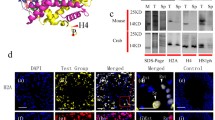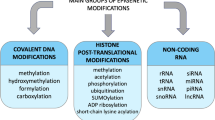Abstract
The testicular H1 histone variant, H1t, is synthesized during spermatogenesis in mammalian male germ cells. In situ hybridization and immunohistochemical techniques were used to assign the expression of either the H1t mRNA or the H1t protein to specific cell stages of spermatogenesis. Our results show the presence of the H1t mRNA only in the late and mid-pachytene stages, whereas the protein occurs first in pachytene spermatocytes, and persists until later stages from round up to elongated spermatids.
Similar content being viewed by others
References
Bhatnagar YM, Faulkner RD, McCullar MK (1985) Biochemical and immunological characterization of an H2A variant of the mouse testis. Biochim Biophys Acta 827:14–22
Brock WA, Trostle PK, Meistrich ML (1980) Meiotic synthesis of testis histones in the rat. Proc Natl Acad Sci USA 77:371–375
Cole KD, Kandala JC, Kistler WS (1986) Isolation of the gene for the testis-specific H1 variant H1t. J Biol Chem 261:7178–7183
DeLucia F, Faraone-Mennella MR, D'Erme M, Quesada P, Caiafa P, Farina B (1994) Histone induced condensation of rat testis chromatin: testis-specific H1t versus somatic HI variants. Biochem Biophys Res Commun 198:32–39
Doenecke D, Albig W, Bouterfa H, Drabent B (1994) Organization and expression of H1 histone and H1 replacement histone genes. J Cell Biochem 54:423–431
Drabent B, Kardalinou E, Doenecke D (1991) Structure and expression of the human gene encoding testicular H1 histone (H1t). Gene 103:263–268.
Drabent B, Bode C, Doenecke D (1993) Structure and expression of the mouse testicular H1 histone gene (H1t). Biochim Biophys Acta 1216:311–313
Gibson JS, Polak JM (1990) Principles and applications of complementary RNA probes. In Polak JM, McGee JOD (eds) In situ hybridization, principles and practice. Oxford University Press, Oxford, pp 81–94
Grabske R, Lake S, Gledhill BL, Meistrich ML (1975) Centrifugal elutriation: separation of spermatogenic cells on the basis of sedimentation velocity. J Cell Physiol 86:177–190
Hotta Y, Chandley AC, Stern H (1977) Biochemical analysis of meiosis in the male mouse. II. DNA metabolism at pachytene. Chromosoma 62:255–268
Kim YJ, Hwang I, Tres LL, Kierszenbaum AL, Chae CB (1987) Molecular cloning and differential expression of somatic and testis-specific H2B histone genes during rat spermatogenesis. Dev Biol 124:23–24.
Kleene KC, Distel RJ, Hecht NB (1984) Translational regulation and deadenylation of a protamine mRNA during spermiogenesis in the mouse. Dev Biol 105:71–79
Kremer EJ, Kistler WS (1991) Localization of mRNA for testis-specific histone H1t by in situ hybridisation. Exp Cell Res 197:330–332
Lennox RW, Cohen H (1984) The alteration in H1 histone complement during mouse spermatogenesis and their significance for H1t subtype function. Dev Biol 103:80–84
Markose ER, Rao MRS (1989) Testis-specific histone H1t is truly a testis-specific variant and not a meiotic-specific variant. Exp Cell Res 182:279–283
McLachlan RI, Wreford NG, Meachem SJ, Dekretser DM, Robertson DM (1994) Effects of testosterone on spermatogenic cell populations in the adult rat. Biol Reprod 51:945–955
Meistrich ML, Bucci LR, Trostle-Weige PK, Brock WA (1985) Histone variants in rat spermatogonia and primary spermatocytes. Dev Biol 112:230–240
Meistrich ML, Trostle-Weige PK, Beek MEAB van (1994) Separation of specific stages of spermatids from vitamin A-synchronized rat testes for assessment of nucleoprotein changes during spermatogenesis. Biol Reprod 51:334–344
Oliva R, Dixon GH (1991) Vertebrate protamine genes and the histone-to-protamine replacement reaction. Prog Nucleic Acids Res Mol Biol 40:25–94
Peschon JJ, Behringer RR, Brinster RL, Palmiter RD (1987) Spermatid-specific expression of protamin 1 in transgenic mice. Proc Natl Acad Sci USA 84:5316–5319
Platz RD, Grimes SR, Meistrich ML, Hnilica LS (1975) Changes in nuclear proteins of rat testis cells separated by velocity sedimentation. J Biol Chem 250:5791–5800
Rao BJ, Brahmachari SK, Rao MRS (1983) Structural organization of the meiotic prophase chromatin in the rat testis. J Biol Chem 258:13478–13485
Russel LD, Ettlin RA, Sinha Hikim AP, Clegg ED (1990) Histological and histopathological evaluation of the testis. Cache River Press, Bolesta Clearwater
Seyedin SM, Kistler WS (1980) Isolation and characterization of rat testis H1t. J Biol Chem 255:5949–5954
Shires A, Carpenter MP, Chalkley R (1975) New histones found in mature mammalian testes. Proc Natl Acad Sci USA 72:2714–2718
Trostle-Weige PK, Meistrich ML, Brock WA, Nishioka K, Bremer JW (1982) Isolation and characterization of TH2A, a germ cell-specific variation of histone 2A in the rat testis. J Biol Chem 257:5560–5567
Trostle-Weige PK, Meistrich ML, Brock WA, Nishioka K (1984) Isolation and characterization of TH3, a germ cell-specific, variant of histone 3 in the rat testis. J Biol Chem 259:8769–8776
Author information
Authors and Affiliations
Rights and permissions
About this article
Cite this article
Drabent, B., Bode, C., Bramlage, B. et al. Expression of the mouse testicular histone gene H1t during spermatogenesis. Histochem Cell Biol 106, 247–251 (1996). https://doi.org/10.1007/BF02484408
Accepted:
Issue Date:
DOI: https://doi.org/10.1007/BF02484408




